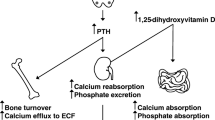Abstract
In addition to the well-documented hyporesponsiveness of the kidney, resistance to parathyroid hormone (PTH) has been postulated for bone in pseudohypoparathyroidism type I (PHP). In some of these patients reduced bone density and even frank osteitis fibrosa suggest osteoclastic overactivity. To address the possibility that the skeletal system of patients with PHP may be affected by their increased PTH secretion we measured intact serum PTH and three biochemical markers of bone turnover in a large number of patients with PHP (n=20). The results were compared with subjects with low (hypoparathyroidism, HP, n=29), normal (controls, n=31) and high (primary hyperparathyroidism, 1°HPT, n=13) PTH secretion. Both markers of osteoblastic bone formation, alkaline phosphatase activity and osteocalcin concentration in serum, and one index of osteoclastic bone degradation, the urinary hydroxyproline/creatinine ratio (OH-P/Cr), were decreased in HP and increased in 1°HPT, whereas only OH-P/Cr was elevated in patients with PHP. Although intact serum PTH was significantly more increased in PHP than in 1°HPT, the markers of bone turnover were not significantly different in these two groups, suggesting some bone resistance in the patients with PHP. In these subjects intact serum PTH was elevated even at normocalcaemia during vitamin D treatment with a negative correlation with the respective serum calcium concentration (r=−0.69, P<0.001), indicating an elevated set-point for the suppression of their parathyroid glands. OH-P/Cr was negatively related to serum calcium in PHP, it normalized in most patients during normocalcaemia induced by vitamin D treatment. The urinary calcium excretion remained normal in the patients with PHP but was markedly elevated in patients with HP after the serum calcium levels had normalized during vitamin D therapy. In conclusion, the present and other studies suggest that the resistance to PTH in patients with PHP is mainly limited to the proximal kidney tubule and that the tendency to increased bone degradation implies either some response of the remodelling bone system to PTH or the result of marked secondary hyperparathyroidism overcoming a partial resistance of bone cells. The aim of vitamin D treatment in patients with PHP should therefore be an elevation of the serum calcium concentration into the high normal-range in order to suppress PTH secretion and thus bone degradation. In these patients the parathyroid glands are less sensitive to circulating calcium levels.
Similar content being viewed by others
Abbreviations
- AHO:
-
Albright's hereditary osteodystrophy
- AMP:
-
adenosine monophosphate
- AP:
-
alkaline phosphatase activity
- Ca:
-
calcium
- Ca/Cr:
-
urinary calcium/creatinine ratio
- Cr:
-
creatinine
- HP:
-
hypoparathyroidism
- 1°HPT:
-
primary hyperparathyroidism
- OH-P/Cr:
-
urinary hydroxyproline/creatinine ratio
- PHP:
-
pseudohypoparathyroidism
- PTH:
-
parathyroid hormone
- SDS:
-
standard deviation score
References
Allen EH, Millard FJC, Nassim JR (1968) Hypo-hyperparathyroidism. Arch Dis Child 43:295–301
Breslau NA, Moses AM, Pak CYC (1983) Evidence for bone remodeling but lack of calcium mobilization response to parathyroid hormone in pseudohypoparathyroidism. J Clin Endocrinol Metab 57:638–644
Cohen RD, Vince FP (1969) Pseudohypoparathyroidism with raised plasma alkaline phosphatase. Arch Dis Child 44:96–101
Drezner MK, Neelon FA (1983) Pseudohypoparathyroidism. In: Stanbury JB, Wyngaarden JB, Fredrickson DS, Goldstein JL, Brown MS (eds) The metabolic basis of inherited disease, 5th edn. McGraw-Hill, New York, pp 1508–1527
Frame B, Hanson CA, Frost HM, Block M, Arnstein AR (1972) Renal resistance to parathyroid hormone with osteitis fibrosa: “pseudohypohyperparathyroidism” Am J Med 52:311–321
Hausamen T-U, Helger R, Rick W Gross W (1967) Optimal conditions for the determination of serum alkaline phosphatase by a new kinetic method. Clin Chim Acta 15:241–245
Kidd GS, Schaaf M, Adler RA, Lassman MN, Wray HL (1980) Skeletal responsiveness in pseudohypoparathyroidism. A spectrum of clinical disease. Am J Med 68:772–781
Kolb FO, Steinbach HL (1962) Pseudohypoparathyroidism with secondary hyperparathyroidism and osteitis fibrosa. J Clin Endocrinol Metab 22:59–70
Kruse K, Kracht U (1983) Total hydroxyproline creatinine ratio in morning fasting urine specimens (OH-P/Cr): a reliable index of bone turnover in children. Monatsschr Kinderheilkd 131:797–803
Kruse K, Kracht U (1986) Evaluation of serum osteocalcin as an index of altered bone metabolism. Eur J Pediatr 145:27–33
Kruse K, Kracht U (1987) A simplified diagnostic test in hypoparathyroidism and pseudohypoparathyroidism type I with synthetic 1-38 fragment of human parathyroid hormone. Eur J Pediatr 146:373–377
Kruse K, Kracht U, Wohlfart K, Kruse U (1988) Intact serum parathormone (PTH 1-84): a suitable parameter for the diagnosis of abnormalities of calcium metabolism. Dtsch Med Wochenschr 113:283–288
Nagant De Deuxchaisnes C, Krane SM (1978) Hypoparathyroidism. In: Alvioli CV, Krane SM (eds) Metabolic bone disease, vol II. Academic Press, New York, pp 218–445
Nusynowitz ML, Frame B, Kolb FO (1976) The spectrum of the hypoparathyroid states: a classification based on physiologic principles. Medicine 55:105–119
Singleton EB, Teng CT (1962) Pseudohypoparathyroidism with bone changes simulating hyperparathyroidism: report of a case. Radiology 38:388–393
Yamamoto M, Takuwa Y, Masuko S, Ogata E (1988) Effects of endogenous and exogenous parathyroid hormone on tubular reabsorption of calcium in pseudohypoparathyroidism. J Clin Endocrinol Metab 66:618–625
Author information
Authors and Affiliations
Rights and permissions
About this article
Cite this article
Kruse, K., Kracht, U., Wohlfart, K. et al. Biochemical markers of bone turnover, intact serum parathyroid hormone and renal calcium excretion in patients with pseudohypoparathyroidism and hypoparathyroidism before and during vitamin D treatment. Eur J Pediatr 148, 535–539 (1989). https://doi.org/10.1007/BF00441552
Received:
Accepted:
Issue Date:
DOI: https://doi.org/10.1007/BF00441552




